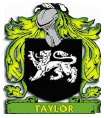|
|
Taylor
Surname Origins
Taylor is an English occupational name for the tailor, from Old French
tailleur late Latin taliare = to cut. It is among the most commonly found
surnames, due to its popularity as a medieval occupation. Variations are
Tayler, Tailour, Taylour . Cognate forms include Tailleur, Letailleur,
Taillandier, Tallendier. Taylorson, Taylerson are patronymic forms of the
name.
Scottish Taylors
The Taylors who are
affiliated with Clan Cameron as a sept are said to be descended from
Donald "Taillear dubh na tuaighe" (Black tailor of the [Lochaber]
axe), who lived in the time of Mary Queen of Scots. He was the
"natural son" of Ewen Cameron, 14th Chief of Clan Cameron and a
daughter of the Chief of Clan MacDougall, out of wedlock. Ewen had Donald
nursed by a tailor's wife at Lundavra; thus the name Taylor. After his
father's death (Ewen died while a captive of the Chief of the MacDougalls,
held prisoner until he agreed to marry the Chief's daughter), Donald would
became the greatest warrior that Clan Cameron had even known.
Acknowledgement of his parentage by his deceased father not being enough
to ascend to the Chiefship, he excelled in the field of battle, usually
against the Cameron's principal foes, the Clan Mackintosh and usually with
his trusty Lochaber axe. In time he would flee rising Cameron-Mackintosh
internal Clan treachery, with a band of loyal followers, to Cowal. The
descendants of his followers there were for ages known as Mac an taillear;
later as Taylor. A tribute to Donald remains in the Cameron Coat of Arms,
where his likeness, along with a Lochaber axe, borders/protects the outer
shield. the time of Mary Queen of Scots. He was the
"natural son" of Ewen Cameron, 14th Chief of Clan Cameron and a
daughter of the Chief of Clan MacDougall, out of wedlock. Ewen had Donald
nursed by a tailor's wife at Lundavra; thus the name Taylor. After his
father's death (Ewen died while a captive of the Chief of the MacDougalls,
held prisoner until he agreed to marry the Chief's daughter), Donald would
became the greatest warrior that Clan Cameron had even known.
Acknowledgement of his parentage by his deceased father not being enough
to ascend to the Chiefship, he excelled in the field of battle, usually
against the Cameron's principal foes, the Clan Mackintosh and usually with
his trusty Lochaber axe. In time he would flee rising Cameron-Mackintosh
internal Clan treachery, with a band of loyal followers, to Cowal. The
descendants of his followers there were for ages known as Mac an taillear;
later as Taylor. A tribute to Donald remains in the Cameron Coat of Arms,
where his likeness, along with a Lochaber axe, borders/protects the outer
shield.
From the Book - A History
of Clan Cameron
As regards the Taillear Dubh, there is a tradition that he went to Cowal
and settled in Stratheachaig. His descendants took the name of
Macintaillear, later changed to Taylor, and many of that name in Cowal are
really Camerons. They are known as Clann an Taillear Dhuibh Chamronaich,
and there seems little doubt Taylors descended from the Cowal families of
Taylor can claim descent from Donald MacEwen Bhig. Professor Malcolm Taylor (Celtic Magazine, September 1884), remarks that -
"In Cowal a group of families, Mac-an-taillear -- later Taylor -- by
name have always regarded themselves as his (the tailleau dubh's)
descendants. ---These Cowal people were wont to regard themselves as
Camerons of the Camerons, and to designate themselves, down to the the
closing years of last (i.e. eighteenth) century as "Clann an Taillear
Dhuibh Chamronach".
TAYLOR
Approved bY the Standing Council of Scottish Chiefs
A
Brief
History:
The name derives from the
French ‘tailler’ meaning to cut, and is rendered in Latin documents as
‘cissor’.
Black states that this is a
very common name in early Scots records.
Alexander le Taillur is
listed as valet to Alexander III in 1276.
Bryce le Taillur was one of
the Scottish prisoners at the capture of Dunbar
Castle in 1296.
The Ragman Roll of the same
year lists six persons of this name from counties as far apart as Roxburgh
and Angus, rendering homage to Edward I of England.
Walter Cissor received a
grant of land from David II around 1137.
Donald Cissor and Bricius
Cissor were witnesses to a deed in Inverness in 1462. The name can also be
found in the form Macintaylor.
Several Macintaileours were
fined in 1613 for sheltering members of the outlawed Clan Gregor.
Gillepatrick Tailzeour was sergeant of Dornoch around 1552.
James Taylor, who was born
in Lanarkshire in 1753, is credited with the first practical application
of steam power to vessels for inland navigation. The first paddle wheel
steam boat was launched on 14 October 1788 at Dalswinton and the
experiment proved a success, the vessel achieving a speed of five miles
per hour.
The great paddle steamers
which later carried passengers and freight on the North American rivers
were derived from Taylor’s original work.
|